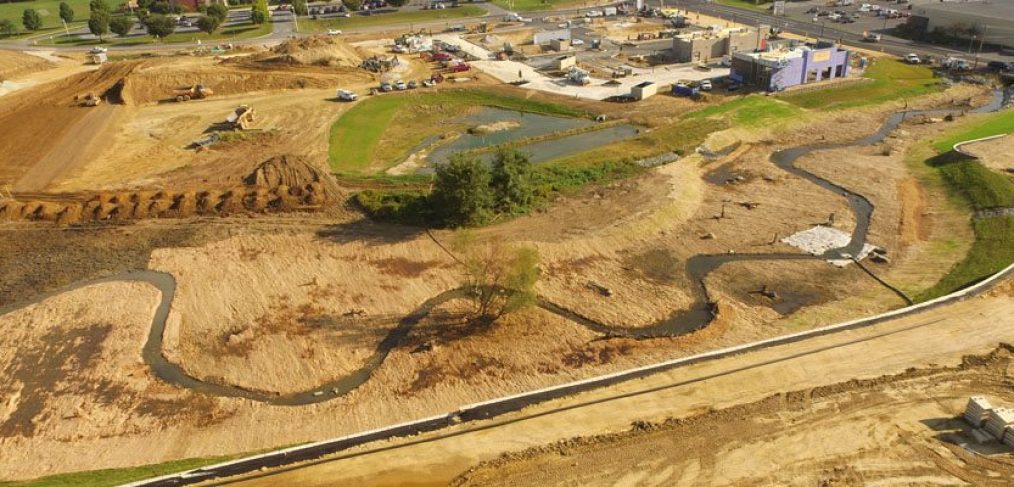
Why Runoff Controls Are an Essential Component of a Municipal Separate Storm Sewer System (MS4)
A Municipal Separate Storm Sewer System (MS4) is made up of a series of stormwater management facilities, inlets, pipes, swales, and outfalls that collect and convey stormwater. Ultimately, many of these discharges end up in local waterways, where runoff, if polluted, can affect water quality. Part of an MS4 community’s permit requires the creation, implementation, and enforcement of a Construction Site Runoff program under Minimum Control Measure (MCM) 4 to keep polluted stormwater runoff from construction sites associated with new development or redevelopment. What a municipality needs to consider is there is also a relationship with construction sites and illicit discharges (MCM 3).
The Impact of Sedimentation
According to the Environmental Protection Agency (EPA), sediment tends to be the main pollutant of concern related to construction site runoff. The agency found that sedimentation impairs approximately 84,503 river and stream miles (12% of the assessed river and stream miles and 31% of the impaired river and stream miles) in the country. Sediment can come from agriculture, urban runoff, construction, and forestry; however, sediment runoff rates from construction sites are usually 10 to 20 times greater than those of agricultural lands and can contribute more sediment to streams in a short time period than can be deposited naturally during several decades. The build-up of sediment and other pollutants from construction sites can cause physical, chemical, and biological problems for our waterways.
Other things an MS4 permittee considers are inlet protection. Asking questions like “are entry points to the MS4 susceptible to discharges from the construction site?” If so, “are the inlets protected by the site operator?” At the end of the day, a municipality is concerned with the nature of discharges entering their systems.
What is Required of MS4 Communities?
MS4 communities need to show the EPA and PA Department of Environmental Protection (DEP) that they are making good-faith and effective efforts to educate developers and other construction site operators of the many ways to prevent runoff from leaving their site and have plans in place to correct situations where runoff does get into the MS4. In Pennsylvania, the Lancaster County Conservation District (LCCD) facilitates the approved “Qualifying Local Program” to issue permits. Since municipalities are the MS4 permit holders and the entity with legal authority, they are responsible for permit compliance. The following are guidelines the EPA has created for MS4 communities to follow:
- Create an ordinance or other regulatory means of requiring the implementation of proper erosion and sediment and waste controls on construction sites of one acre or more in size.
- Review construction site plans before any ground has been broken to determine potential water quality impacts and track progress throughout the construction phase.
- Develop site inspection and enforcement of control measures procedures. Procedures could include how to identify priority sites for inspection and enforcement (based on type and scale of construction activity, site topography, soil characteristics, etc.).
- Use the ordinance/regulatory mechanism to outline compliance steps and sanctions (typically a warning and education followed by escalating enforcement procedures).
- Incorporate a process for receiving, tracking, and considering public comments, suggestions, and concerns on the program and specific construction sites.
- Determine appropriate best management practices (BMPs) and measurable goals for the program.
Creating Measurable Goals
An MS4 community’s stormwater management plan (SWMP) should contain measurable goals for each of the MCMs, which will help show that efforts are working when it comes time to submit the annual MS4 permit report. For MCM 4, one measurable goal could be that at least 80% of construction sites are compliant by implementing and maintaining their BMPs. Educational efforts, like educating construction site operators and contractors about proper selection, installation, inspection, and maintenance of on site stormwater BMPs, are an example of what could be used to reach this goal which is measured through inspections. If less than 80% of construction sites are compliant, than this is an indicator that the educational approaches need to be modified.
Implementation steps and milestones are used to provide baseline numbers to help measure against effectiveness. Examples of these include, tracking the number of educational pamphlets distributed, the number of operators in attendance at training events, and the number of participants in online webinars. MS4 communities can encourage more participation in educational efforts by decreasing permit fees for contractors who can show that they attended a training.
Project Example
The Brubaker Run – Lime Spring Square development project in East Hempfield Township, Lancaster County, showcases the importance of MCM 4. The site is 98-acres and will contain a mix of industrial, commercial, retail, office space, and a community park. Brubaker Run flows through the site, so keeping sediment-laden runoff out of the stream is essential to making sure the construction activities do not impact East Hempfield Township’s MS4 permit.
East Hempfield Township is doing their part with MCM 4 implementation; they have an ordinance in place, have reviewed the site plans for the Lime Spring Square development, and continue to track progress on the site to ensure Oak Tree Developers and their contractors are properly installing and maintaining the BMPs. Should an issue arise, the municipality will work with the developer to quickly remedy the situation.
To learn more about the Brubaker Run – Lime Spring Square project and see drone video footage of the site, click here.
Final Thoughts
By educating construction site operators and contractors about the importance of on-site stormwater BMPs, an MS4 community not only ensures compliance with state and federal regulations, but also gains peace of mind that local waterways will not face the threat of sedimentation and other pollutants from construction site activities.
More information on MCM 4, as well as examples of checklists, procedures, and other relevant documents can be found here.



